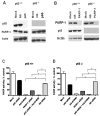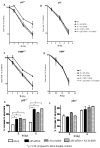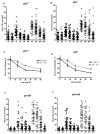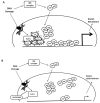NF-κB mediates radio-sensitization by the PARP-1 inhibitor, AG-014699
- PMID: 21706052
- PMCID: PMC3191117
- DOI: 10.1038/onc.2011.229
NF-κB mediates radio-sensitization by the PARP-1 inhibitor, AG-014699
Erratum in
-
Correction to: NF-κB mediates radio-sensitization by the PARP-1 inhibitor, AG-014699.Oncogene. 2023 Feb;42(6):471. doi: 10.1038/s41388-022-02524-2. Oncogene. 2023. PMID: 36482204 No abstract available.
Abstract
The stress-inducible transcription factor, nuclear factor (NF)-κB induces genes involved in proliferation and apoptosis. Aberrant NF-κB activity is common in cancer and contributes to therapeutic-resistance. Poly(ADP-ribose) polymerase-1 (PARP-1) is activated during DNA strand break repair and is a known transcriptional co-regulator. Here, we investigated the role of PARP-1 function during NF-κB activation using p65 small interfering RNA (siRNA), PARP siRNA or the potent PARP-1 inhibitor, AG-014699. Survival and apoptosis assays showed that NF-κB p65(-/-) cells were more sensitive to ionizing radiation (IR) than p65(+/+) cells. Co-incubation with p65 siRNA, PARP siRNA or AG-014699 radio-sensitized p65(+/+), but not p65(-/-) cells, demonstrating that PARP-1 mediates its effects on survival via NF-κB. Single-strand break (SSB) repair kinetics, and the effect SSB repair inhibition by AG-014699 were similar in p65(+/+) and p65(-/-) cells. As preventing SSB repair did not radio-sensitize p65(-/-) cells, we conclude that radio-sensitization by AG-014699 is due to downstream inhibition of NF-κB activation, and independent of SSB repair inhibition. PARP-1 catalytic activity was essential for IR-induced p65 DNA binding and NF-κB-dependent gene transcription, whereas for tumor necrosis factor (TNF)-α-treated cells, PARP-1 protein alone was sufficient. We hypothesize that this stimulus-dependent differential is mediated via stimulation of the poly(ADP-ribose) polymer, which was induced following IR, not TNF-α. Targeting DNA damage-activated NF-κB using AG-014699 may therefore overcome toxicity observed with classical NF-κB inhibitors without compromising other vital inflammatory functions. These data highlight the potential of PARP-1 inhibitors to overcome NF-κB-mediated therapeutic resistance and widens the spectrum of cancers in which these agents may be utilized.
Figures







Similar articles
-
Ionizing radiation-induced NF-kappaB activation requires PARP-1 function to confer radioresistance.Oncogene. 2009 Feb 12;28(6):832-42. doi: 10.1038/onc.2008.439. Epub 2008 Dec 8. Oncogene. 2009. PMID: 19060926 Free PMC article.
-
Poly(ADP-ribose) polymerase-1-induced NAD(+) depletion promotes nuclear factor-κB transcriptional activity by preventing p65 de-acetylation.Biochim Biophys Acta. 2013 Aug;1833(8):1985-91. doi: 10.1016/j.bbamcr.2013.04.005. Epub 2013 Apr 15. Biochim Biophys Acta. 2013. PMID: 23597856 Free PMC article.
-
Poly(ADP-ribose) polymerase-1 is a determining factor in Crm1-mediated nuclear export and retention of p65 NF-kappa B upon TLR4 stimulation.J Immunol. 2010 Aug 1;185(3):1894-902. doi: 10.4049/jimmunol.1000646. Epub 2010 Jul 7. J Immunol. 2010. PMID: 20610652 Free PMC article.
-
Structure and function of poly(ADP-ribose) polymerase-1: role in oxidative stress-related pathologies.Curr Vasc Pharmacol. 2005 Jul;3(3):209-14. doi: 10.2174/1570161054368625. Curr Vasc Pharmacol. 2005. PMID: 16026317 Review.
-
Poly (adp-ribose) polymerase inhibitors as potential therapeutic agents in stroke and neurotrauma.Curr Drug Targets CNS Neurol Disord. 2005 Apr;4(2):179-94. doi: 10.2174/1568007053544138. Curr Drug Targets CNS Neurol Disord. 2005. PMID: 15857303 Review.
Cited by
-
The diverse and complex roles of NF-κB subunits in cancer.Nat Rev Cancer. 2012 Jan 19;12(2):121-32. doi: 10.1038/nrc3204. Nat Rev Cancer. 2012. PMID: 22257950 Review.
-
The Synergistic Effect of PARP Inhibitors and Immune Checkpoint Inhibitors.Clin Med Insights Oncol. 2021 Feb 25;15:1179554921996288. doi: 10.1177/1179554921996288. eCollection 2021. Clin Med Insights Oncol. 2021. PMID: 33737855 Free PMC article. Review.
-
Regulation of response to radiotherapy by β-arrestin1 in Non-small cell lung cancer.J Cancer. 2019 Jul 8;10(17):4085-4095. doi: 10.7150/jca.30012. eCollection 2019. J Cancer. 2019. PMID: 31417653 Free PMC article.
-
Rucaparib: First Global Approval.Drugs. 2017 Apr;77(5):585-592. doi: 10.1007/s40265-017-0716-2. Drugs. 2017. PMID: 28247266 Review.
-
Tumor suppressor p53 independent apoptosis in HT-29 cells by auransterol from Penicillium aurantiacobrunneum.Biomed Pharmacother. 2020 Jul;127:110124. doi: 10.1016/j.biopha.2020.110124. Epub 2020 May 11. Biomed Pharmacother. 2020. PMID: 32407985 Free PMC article.
References
-
- Althaus FR, Hofferer L, Kleczkowska HE, Malanga M, Naegeli H, Panzeter PL, et al. Histone shuttling by poly ADP-ribosylation. Mol Cell Biochem. 1994;138:53–9. - PubMed
-
- Barkett M, Gilmore T. Control of apoptosis by Rel/NF-kappaB transcription factors. Oncogene. 1999;18:6910–24. - PubMed
-
- Basseres DS, Baldwin AS. Nuclear factor-kappaB and inhibitor of kappaB kinase pathways in oncogenic initiation and progression. Oncogene. 2006;25:6817–6830. - PubMed
Publication types
MeSH terms
Substances
Grants and funding
LinkOut - more resources
Full Text Sources
Other Literature Sources
Research Materials
Miscellaneous

